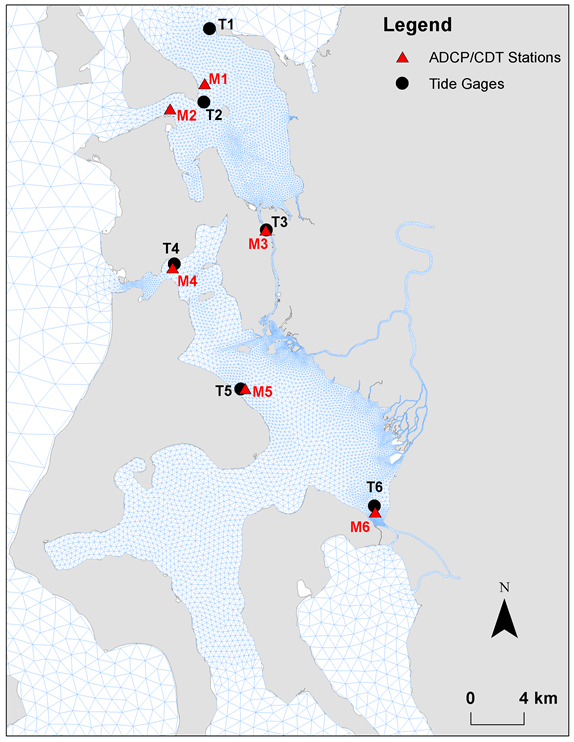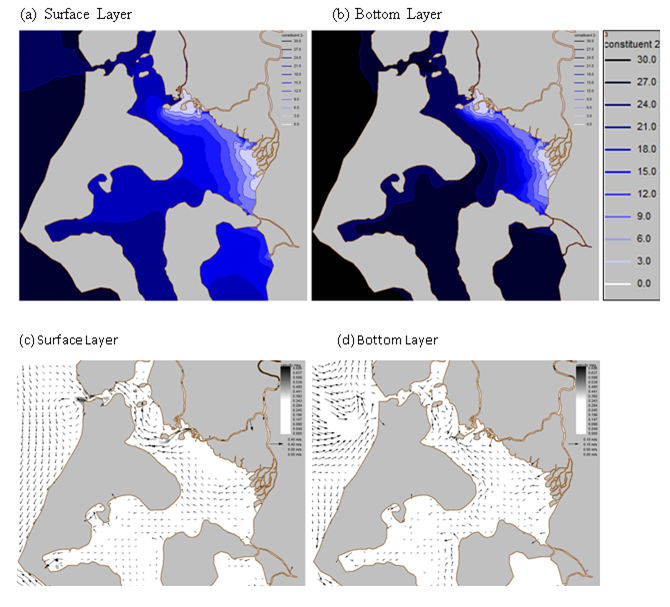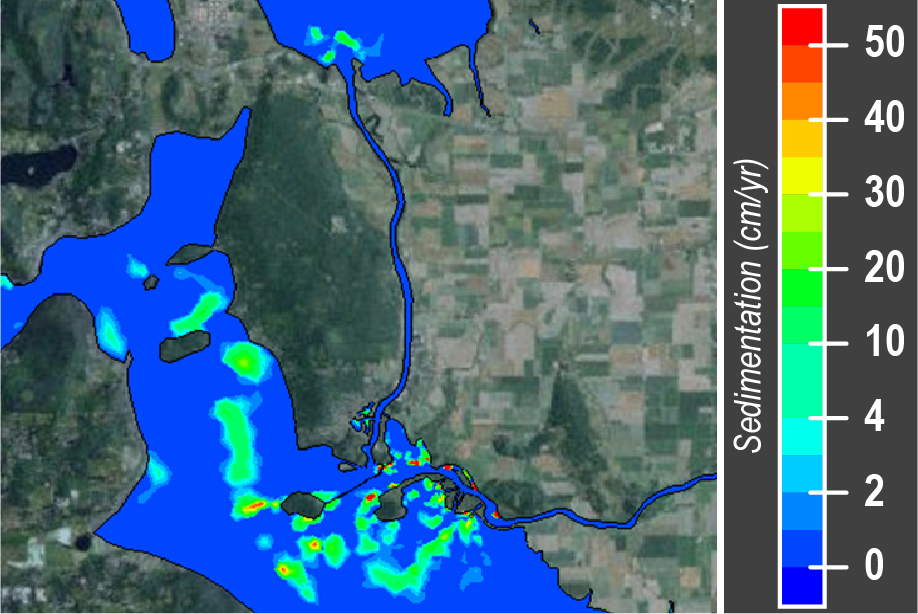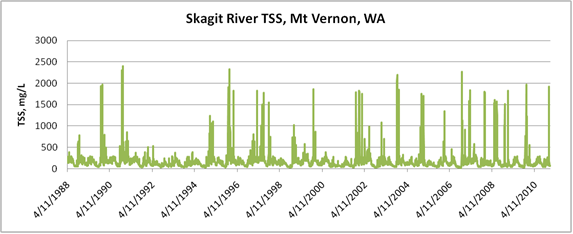SSM Sediment Transport: Skagit and Padilla Bay
Hydrodynamic and Suspended Sediment Transport Model of Skagit and Padilla Bay System (Sensitivity to Sea Level Rise and Future Flows)

This project was motivated primarily by a deep concern about the possibility of a projected sea-level rise and future hydrologic changes affecting coastal fisheries through altered circulation and transport, reduction of available brackish tidal marsh habitat, and increased turbidity. Higher salinity and turbidity in the river distributaries could affect drinking water and agricultural water supplies and drainage. However, there is a lack of quantitative site-specific information and considerable uncertainty about the extent and magnitude of resulting estuarine response due to the oceanographic complexity associated with the Skagit sub-basin within the Puget Sound inland fjord setting.
The overall objective of this project was to develop a practical tool that can predict ecological consequences and likely impacts on the landscape from sea-level rise and future river flow and sediment load alteration. We made progress toward achieving this objective by developing and linking a spatially explicit hydrodynamic and sediment transport model of Padilla Bay and Skagit Bay to inform the development of a mechanistic wetland elevation dynamics and vegetation unit model (Western Washington University [WWU]), and development of models of tidal channel geomorphology and juvenile salmon abundance and distribution (Skagit River System Cooperative).
A fine-scale finite volume Finite Volume Coastal Ocean Model (FVCOM) model grid of the Skagit-Padilla Bay nested within the intermediate-scale Salish Sea Model grid along with water-quality monitoring stations is shown in the figure above.
Hydrodynamic Model - Existing Conditions (2008 Baseline)
The hydrodynamic model of Skagit Bay has been calibrated over the years through a combination of multiple prior projects. With improvements to grid resolution and bathymetry and the availability of new data, it was further validated as part of this effort, and is considered well established (Khangaonkar et al. 2016). The model domain has also been expanded by Yang et al. (2012) upstream of the estuary over the coastal floodplain to facilitate integrated modeling of flood flows and tidal hydrodynamics.
The figure below provides an example of results - velocity vector and salinity contour maps for surface and bottom layers showing the direction of residual currents and salinity distribution based on hourly results averaged over the year 2008.

Sediment Transport Model - Existing Conditions (1988 to 2010)
The sediment transport and deposition model was our first attempt to simulate sediment deposition in the system using the FVCOM hydrodynamic solution for the combined Skagit-Padilla Bay domain.

A time history of total suspended solids (TSS) loading from Skagit River spanning a period of 23 years (1988 to 2010) was developed using a sediment load rating curve developed by the U.S. Geological Survey (USGS) and flow data from the Mt. Vernon USGS gage. Based on this record, the Skagit River averages a sediment discharge of nearly 4 million T/yr of sediment, at an average TSS concentration of 162 mg/L. The settling velocity of a median grain size 0.06-mm particle was specified as 2.66 mm/s using Stokes law. The sediment erosion rate calculations were based on the pickup function described by Van Rijn (1984). The figure below shows the TSS loading time history. The figure on the left is a map of sediment deposition rates in centimeters per year based on simulation over a period from 1998 to 2010.

Future Conditions — Year 2070 Hydrology and Sea-Level Rise and Altered Hydrology
Future climate assessments for the Pacific Northwest conducted by the University of Washington Climate Impacts Group (UW-CIG), based on global climate model (GCM) simulations corresponding to the various emissions scenarios B1, B2, A1B, B2, A1F1 (low emissions to the high emissions) from the Intergovernmental Panel on Climate Change Fourth Assessment Report (IPPCC AR4) were used to estimate future river flows (Hamlet 2010, Lee and Hamlet 2013, in press). The figure below shows a comparison of a present and predicted future hydrograph for the Skagit River. Similarly, the figure in the left panel shows polynomial fits to the sea-level rise projections for tears 2030, 2050, and 2100 developed under a National Research Council Effort (NRC 2012). An assessment of the sensitivity of circulation and transport in the Skagit River estuary to sea-level rise and future climate including hydrologic change is in progress.
Project Highlights
Considerable improvement is needed to improve our ability to simulate movement and transport of sediments and the evolution of the Skagit River delta. This includes addition of processes such as bedload transport, multiple grain size, and geomorphological modeling to predict channel migration and bank erosion. A sediment transport model has also not been calibrated or validated with a robust long-term monitoring TSS and bed thickness data set. The sediment transport modeling results therefore must be treated as preliminary and best viewed as sensitivity test results. Yet these preliminary results provide valuable insight into sediment transport properties in the Skagit River system.
Specific conclusions are as follows:
- The bed sediments routinely sampled and characterized by different groups as part of various studies consistently report grain sizes in the medium sand size class (0.4 mm to 0.6 mm). Our results based on review of new data from the USGS and modeling analysis indicate that these sediments remain in the system and are likely a part of the bedload fraction. A majority of discharged sediments (nearly 97%) of the load from the Skagit River is in the suspended mode and is transported out into Skagit Bay.
- Most of the sediment appears to be transported out via the North Fork of the Skagit River conduit, likely because the North Fork carries larger fraction of the total flow.
- Model simulations show that a very small fraction of Skagit River sediments is transported out to Padilla Bay. This is validated by the field data collected by WWU, which shows most of the stations in Padilla Bay indicate erosion.
- The deposition rate of about 7 cm/yr matches the measured accretion rate of 8 cm/yr by WWU at a depositional site near the mouth of North Fork of the Skagit River.
Model runs for hydrodynamics and salinity predictions under various sea-level rise and river flow scenarios are in progress. Results can inform restoration goals, strategy revisions, and adaptive management responses depending on how much marsh progradation or erosion occurs over the next century. The study will characterize high- or low-risk restoration sites based on likely vulnerability or resilience to climate change.
Contacts and Project Team
- Western Washington University: John Rybczyk (PI)
- PNNL: Tarang Khangaonkar, Zhaoqing Yang, Cheegwan Lee, Taiping Wang
- Skagit River System Cooperative: Greg Hood
Study Reports and Publications
Khangaonkar T, Z Yang, C Lee, T Wang. 2013. Hydrodynamic and Suspended Sediment Transport Model of Skagit and Padilla Bay System. Prepared for Western Washington University as part of U.S. EPA NCER STAR GRANT: Nonlinear Responses to Global Change in Linked Aquatic and Terrestrial Ecosystems and Effects of Multiple Factors on Terrestrial Ecosystems.
Khangaonkar T, W Long, B Sackmann, T Mohamedali, and A Hamlet. 2016. Sensitivity of Circulation in the Skagit River Estuary to Sea Level Rise and Future Flows. Northwest Science, 90(1): 94-118. doi: 10.3955/046.090.0108.
Yang Z, T Wang, T Khangaonkar, and S Breithaupt. 2012. Integrated modeling of flood flows and tidal hydrodynamics over a coastal floodplain. Journal of Environmental Fluid Mechanics, 12(1): 63-80. doi: 10.1007/s10652-011-9214-3.